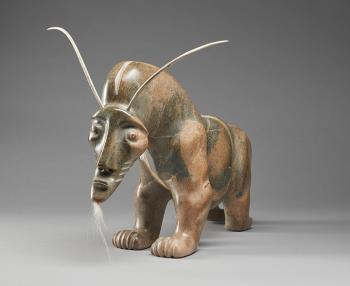Image Caption
Summary
Local Journalism Initiative Reporter
Windspeaker.com
Renowned Inuvialuit artist David Ruben Piqtoukun has had his share of accolades throughout his lengthy career.
Piqtoukun now has another. His solo exhibition, titled Radical Remembrance, is now open at the Toronto-based Art Gallery of Ontario (AGO), one of North America’s largest art museums.
The exhibition features 50 pieces in honour of the 50 years he has spent sculpting and stone carving.
“When I look back, I see a lot of effort went into the actual presentation,” Piqtoukun said at the AGO on Jan. 25 during a media tour of his exhibition.
Piqtoukun, who was born in 1950, is from Paulatuk, a hamlet in the Northwest Territories. He now lives in the eastern Ontario town of Belleville.
At the age of five, Piqtoukun was taken from his home and sent to a residential school. His brother introduced him to stone carving when he was 22.
Throughout his artistic career Piqtoukun has tried to relate the oral histories stolen from him during his years at residential school.
He explained the Radical part of the name of his exhibition reflects someone in conflict.
“All my life I’ve been in conflict with the Roman Catholic Church and their concept of boarding schools,” he said.
Piqtoukun was recognized this past year for his lengthy career. He was the recipient of a Governor General’s Award for Visual and Media Arts in 2022.
“It was great to be acknowledged for something that I did most of my life,” he said. “A lot of people say it’s a big accomplishment. I was acknowledged and I’m very proud of that. I know how I started and why I began. And suddenly I’m in the limelight.”
Wanda Nanibush, AGO’s curator of Indigenous art, is thrilled the museum is now featuring Piqtoukun’s solo exhibition, which will continue until June 25.
“I think it’s really important to honour David’s long career,” Nanibush said. “Fifty years and this is his first solo exhibition at the Art Gallery of Ontario and it’s really important that we acknowledge his career, his life, his skill. He’s one of our best.”
Nanibush, a member of Beausoleil First Nation in Ontario, started working at the AGO in 2016. Shortly thereafter she helped develop her position of curator of Indigenous art.
Last year the AGO also hired Taqralik Partridge as an associate curator of Indigenous art, with a focus on Inuit art.
“I think the AGO is showing much more of a commitment to Inuit art,” Nanibush said. “So, we’re going to see and do a lot more exhibitions and shows. This is great.”
Radical Remembrance includes numerous pieces from the early portions of Piqtoukun’s career. But there are also several works that were completed in recent years.
Nanibush said she purposely selected 50 pieces to be in the exhibition to reflect Piqtoukun’s 50-year career.
“The other part is I wanted to show how much he works with different materials over time so whether he’s working with stone, metal or bone, his combinations of these works are really unique from the very beginning to now,” she said. “There’s a lot of connections through time but you can also see his experimentations and where he is going. It’s nice to see his progression too.”
One of the more recent pieces of work in Radical Resemblance, titled Thar She Blows!, is a nine-foot sculpture made from a blue whale jawbone.
Thar She Blows is an expression shouted when a whale is spotted surfacing from the water expelling a breath with a plume of sea water out its blowhole. Piqtoukun’s sculpture allows him to provide some commentary on his climate change concerns.
While viewing this particular sculpture, Piqtoukun said people can use their imagination that this is the last blue whale in existence.
“I’ve never seen a blue whale,” he added. “But I’ve seen other large whales.”
Nanibush said some other pieces of the exhibition also reflect Piqtoukun’s thoughts on what is transpiring globally, adding some pieces in the collection reflect the fact Inuit people consider their land the centre and everything else as south.
“It’s a good reminder that when you live in Toronto or you live in the south, you think you are the centre,” Nanibush said. “And (Indigenous people in the north) think they are the centre. And a lot of what’s happening in the world and a lot of David’s work, especially the recent work dealing with the environmental crisis, we have to really think about the north and what is being done and how much is happening there first.”
Local Journalism Initiative Reporters are supported by a financial contribution made by the Government of Canada.

